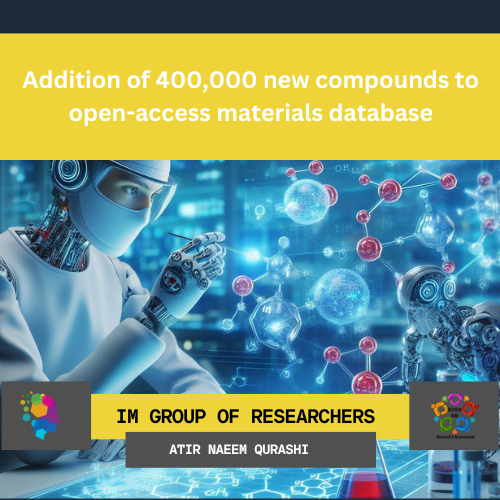Addition of 400,000 new compounds to open-access materials database
The addition expands the open-access resources utilized by scientists for innovating new materials in anticipation of future technologies. The Berkeley Lab’s Materials Project provides researchers with essential information about a variety of materials. At present, Google DeepMind, Google’s artificial intelligence lab, is making a contribution with the Addition of 400,000 new compounds to open-access materials database.
Author:
Atir Naeem Qurashi

LinkedIn: Click here to see Atir’s profile
Emerging technologies frequently require novel materials, and thanks to supercomputers and simulations, researchers can bypass inefficient guesswork and invent them with precision.
Established in 2011 at the Lawrence Berkeley National Laboratory, the Materials Project is an open-access database that calculates the properties of both existing and anticipated materials. This empowers researchers to concentrate on potential materials for upcoming technologies, envisioning advancements such as lighter alloys for enhanced car fuel economy, more efficient solar cells to amplify renewable energy, or swifter transistors for the next era of computers.
Presently, Google DeepMind, Google’s artificial intelligence lab, is adding close to 400,000 new compounds to the Materials Project, broadening the wealth of information available to researchers. This dataset encompasses details on the arrangement of atoms in a material (its crystal structure) and its stability (formation energy).
“We have to create new materials if we are going to address the global environmental and climate challenges,” stated by Kristin Persson, the founder and director of the Materials Project at Berkeley Lab and a professor at UC Berkeley. “With innovation in materials, we can potentially develop recyclable plastics, harness waste energy, make better batteries, and build cheaper solar panels that last longer, among many other things.”
In generating the latest data, Google DeepMind crafted a deep learning tool named Graph Networks for Materials Exploration, abbreviated as GNoME. By utilizing workflows and data refined over a decade by the Materials Project, researchers trained GNoME. The GNoME algorithm was further enhanced through active learning. Ultimately, GNoME researchers generated 2.2 million crystal structures, including 380,000 deemed stable and slated for addition to the Materials Project. These stable structures hold potential for future technologies. The outcomes of Google DeepMind’s efforts are featured in the latest edition of the journal Nature.
To evaluate A-Lab, a facility at Berkeley Lab where robots guided by artificial intelligence create new materials, researchers utilized computations from GNoME along with data from the Materials Project. The inaugural paper from A-Lab, featured in latest edition of Nature, demonstrates the autonomous lab’s capability to swiftly uncover innovative materials with minimal human intervention.
Operating independently for 17 days, A-Lab achieved the successful creation of 41 new compounds out of 58 attempts, averaging more than two new materials per day. In contrast, human researchers might take months of trial and error to develop a single new material, and there’s no guarantee of reaching the desired material at all.
To craft the innovative compounds anticipated by the Materials Project, A-Lab’s AI devised new formulations by sifting through scientific papers and employing active learning for adjustments. The stability of the predicted materials was assessed using data from both the Materials Project and GNoME.
The Materials Project stands as the world’s most extensively utilized open-access repository for inorganic materials information. Hosting millions of properties related to hundreds of thousands of structures and molecules, the database is predominantly processed at Berkeley Lab’s National Energy Research Science Computing Center. With over 400,000 registered users, the site sees an average of more than four papers citing the Materials Project published each day. Notably, the contribution from Google DeepMind marks the most significant addition of structure-stability data from a group since the inception of the Materials Project.
Over the last decade, researchers have explored promising leads from the data provided by the Materials Project, confirming useful properties in new materials across various domains. Some of these materials exhibit potential applications:
- Carbon capture (for extracting carbon dioxide from the atmosphere)
- Photocatalysts (materials accelerating chemical reactions in response to light, useful for breaking down pollutants or generating hydrogen)
- Thermoelectrics (materials that could convert waste heat into electrical power)
- Transparent conductors (with potential applications in solar cells, touch screens, or LEDs)
However, identifying these promising materials is just one step among many in addressing significant technological challenges faced by humanity.
Also Read: The Cosmic Significance of Chemistry: Exploring Its Role in Our Lives
Source: following are the sources for our article “Addition of 400,000 new compounds to open-access materials database”.
1- newscenter
2- sciencedaily
Follow Us on

